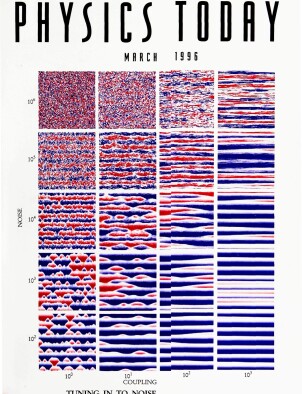Tuning in to Noise
DOI: 10.1063/1.881491
Two sweeping generalizations can be made about most natural systems: They are intrinsically nonlinear and they operate in noisy environments. Examples abound, ranging from weather systems to oscillating chemical reactions to the movements of an eel. The most complex example is arguably the human central nervous system, flooded as it is with the “noise” of modern life.
This article is only available in PDF format
References
1. R. Benzi, A. Sutera, A. Vulpiani, J. Phys. A 14, L453 (1981).
2. L. Gammaitoni et al., Phys. Rev. Lett. 62, 349 (1989). https://doi.org/PRLTAO
B. McNamara, K. Wiesenfeld, Phys. Rev. A 39, 4854 (1989).https://doi.org/PLRAAN3. K. Wiesenfeld, F. Moss, Nature 373, 33 (1995).https://doi.org/NATUAS
4. F. Moss, A. Bulsara, M. Shlesinger, eds., Proc. NATO Adv. Research Wksp. on Stochastic Resonance in Phys. and Biology, J. Stat. Phys. 70, (1993).
5. Nuovo Cimento D 17, (1995).
(Papers from the Int. Wksp. On Fluctuations in Phys. and Biology: Stochastic Resonance, Signal Processing, and Related Phenomena).6. P. Jung, P. Hanggi, Phys. Rev. A 44, 8032 (1991). https://doi.org/PLRAAN
H. Gang, G. Nicolis, C. Nicolis, Phys. Rev. A 42, 2030 (1990).
M. Dykman et al., Phys. Lett. A 180, 332 (1993). https://doi.org/PYLAAG
P. Jung, Phys. Rep. 234, 175 (1993).https://doi.org/PRPLCM7. L. Gammaitoni, F. Marchesoni, S. Santucci, Phys. Rev. Lett. 74, 1052 (1995).https://doi.org/PRLTAO
8. J. Douglass et al., Nature 365, 337 (1993). https://doi.org/NATUAS
S. Bezrukov, I. Vodyanoy, Nature 378, 362 (1995).https://doi.org/NATUAS9. M. deWeese, W. Bialek, in ref. 5.J. Collins, C. Chow, T. Imhoff, Phys. Rev. E 52, 315 (1995). https://doi.org/PLEEE8
L. Kiss, in Proc. 2nd Int. Mtg. On Nonlinear Dynamics and Full Spectrum Processing, AIP Press, to appear. J. Levin, J. Miller, Nature (1996), in press. A. Zador, A. Bulsara, Phys. Rev. E, submitted.10. A. Longtin, A. Bulsara, F. Moss, Phys. Rev. Lett. 67, 656 (1991). https://doi.org/PRLTAO
A. Longtin et al., Biol. Cybern. 70, 569 (1994).https://doi.org/BICYAF11. See for example J. Rose et al., J. Neurophys. 30, 769 (1967).
H. Braun et al., Nature 367, 270 (1994).https://doi.org/NATUAS12. J. Lindner et al., Phys. Rev. Lett. 75, 3 (1995). https://doi.org/PRLTAO
M. Inchiosa, A. Bulsara, Phys. Rev. E 52, 327 (1995). https://doi.org/PLEEE8
We also invite readers to visit http://hpcweb.nosc.mil/hpc/sr/sr.html on the World Wide Web.13. L. Gammaitoni, Phys. Rev. E 52, 4691 (1995).https://doi.org/PLEEE8
14. B. McNamara, K. Wiesenfeld, R. Roy, Phys. Rev. Lett. 60, 2626 (1988). https://doi.org/PRLTAO
L. Gammaitoni et al., Phys. Rev. Lett. 67, 1799 (1991). https://doi.org/PRLTAO
J. Iannelli et al., Appl. Phys. Lett. 65, 1983 (1994). https://doi.org/APPLAB
B. Jost, B. Saleh, Opt. Lett. 21, 287 (1996). https://doi.org/OPLEDP
A. Hibbs et al., J. Appl. Phys. 77, 2582 (1995). https://doi.org/JAPIAU
R. Rouse, S. Han, J. Lukens, Appl. Phys. Lett. 66, 108 (1995). https://doi.org/APPLAB
M. Dykman et al., Appl. Phys. Lett. 67, 308 (1995).https://doi.org/APPLAB
More about the Authors
Adi R. Bulsara. Naval Command, Control and Ocean Surveillance Center, RDT&E Division, San Diego, California.
Luca Gammaitoni. University of Perugia.




